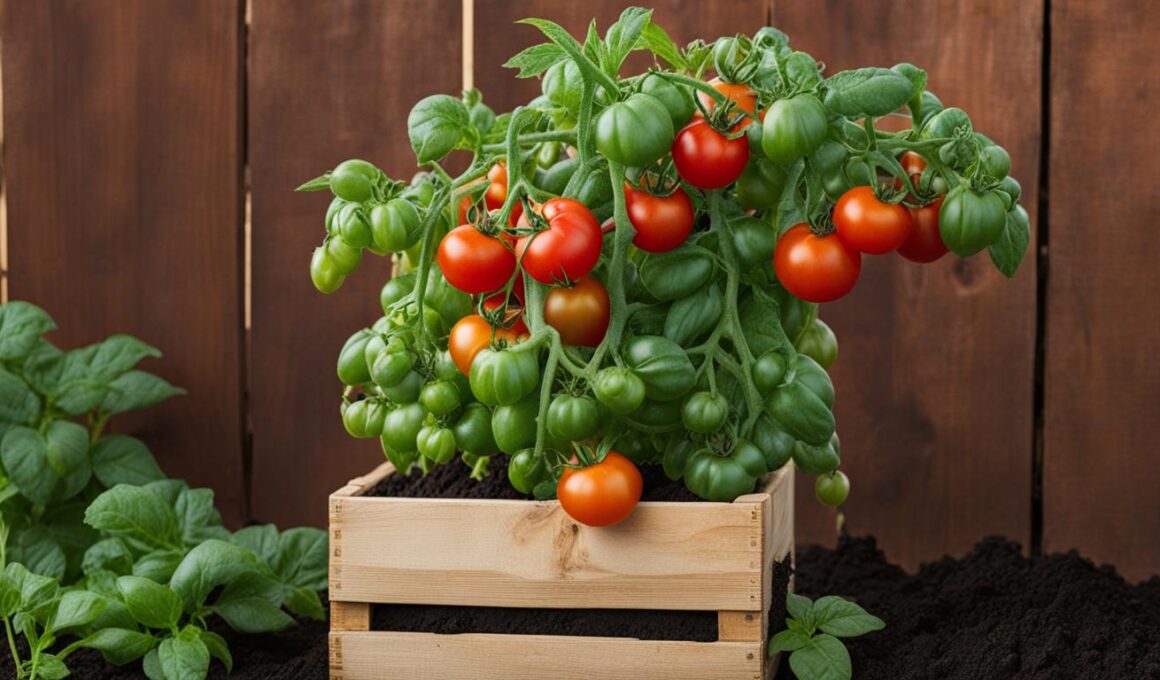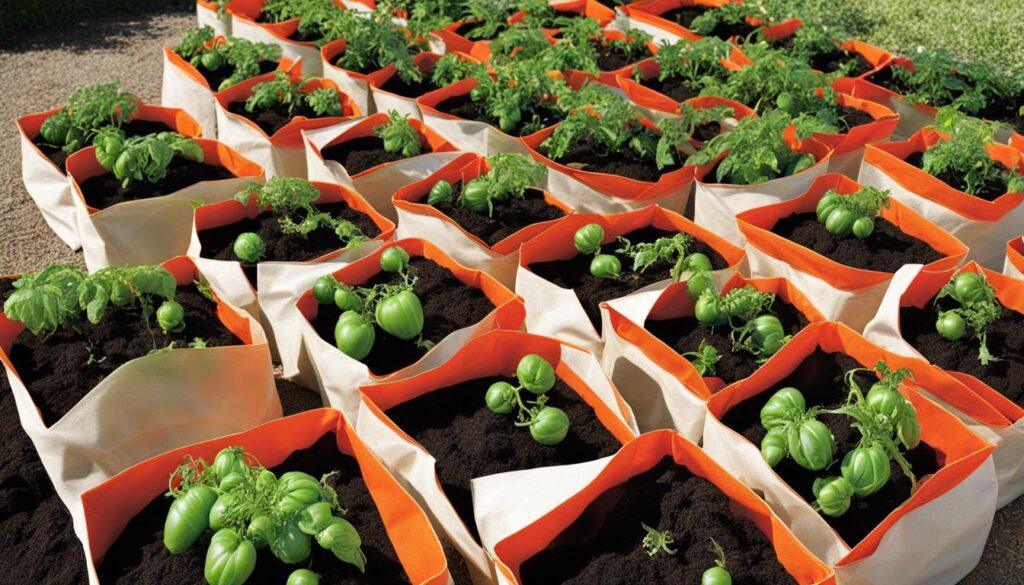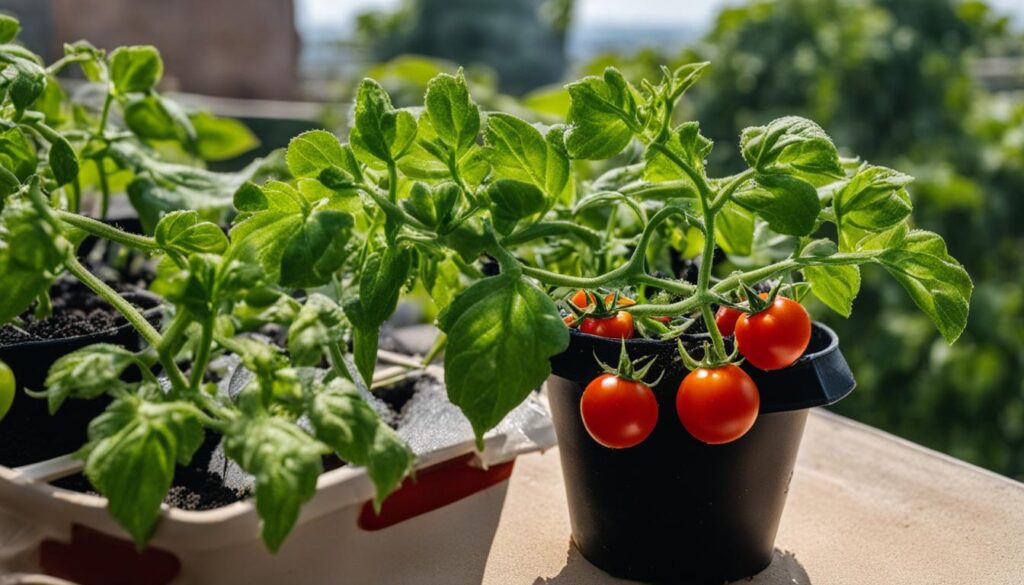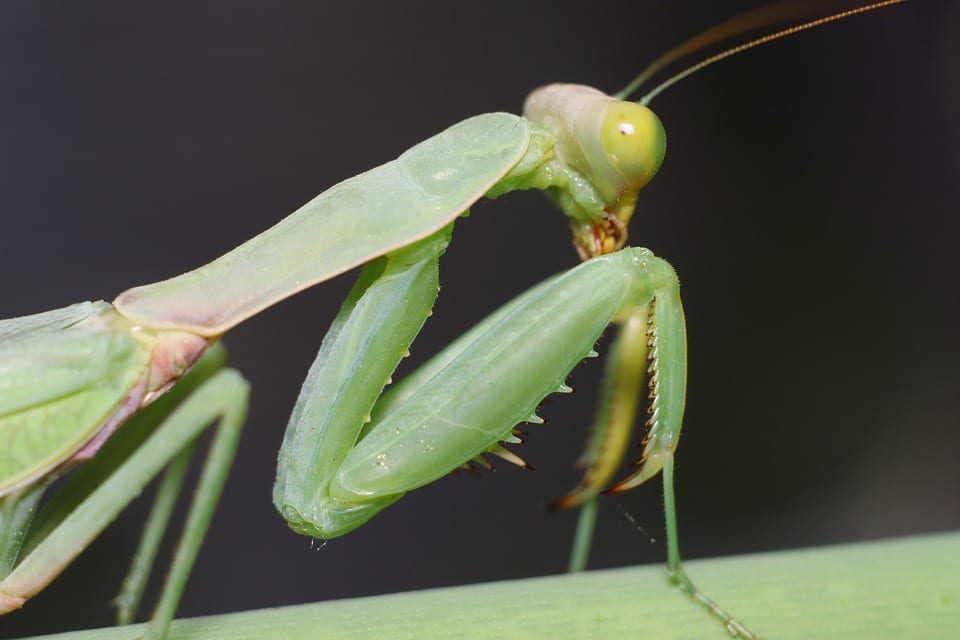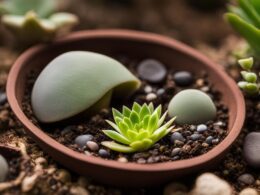Growing tomatoes in potting soil bags has become increasingly popular as a way to garden in small spaces and reduce disease pressure. With the right grow bags and techniques, you can successfully grow tomatoes in limited areas like decks, patios, and porches. In this comprehensive guide, we will discuss the advantages of using grow bags, the types of grow bags available, and step-by-step instructions for growing tomatoes in grow bags. We will also provide tips for choosing the right tomato varieties for grow bags and how to care for your plants to ensure a bountiful tomato harvest.
Key Takeaways:
- Growing tomatoes in potting soil bags is a practical solution for small garden spaces.
- Using grow bags reduces disease pressure and promotes healthy root systems.
- Choose fabric grow bags for optimal plant growth and root development.
- Follow the step-by-step instructions for successful tomato cultivation in grow bags.
- Consider sunlight, watering, fertilizing, and pruning techniques for optimal tomato growth.
Why Use Grow Bags for Tomato Gardening?
There are several advantages to using grow bags for tomato gardening. Firstly, grow bags allow you to grow tomatoes in tight spaces like decks, patios, and driveways, making tomato growing possible even with limited area. With the right grow bags, you can take advantage of vertical gardening and maximize your growing space. This is especially beneficial for urban gardeners or those with small yards.
Secondly, grow bags reduce the risk of disease. By elevating the tomato plants, using sterilized potting mix, and keeping them separate from other plants, grow bags create a healthier growing environment. The good airflow and drainage provided by grow bags also promote healthy root systems through a process called “air pruning,” which prevents root circling and encourages strong, robust plants.
“Grow bags allow you to grow tomatoes in tight spaces and reduce the risk of disease, making them an ideal choice for urban gardeners or those with limited gardening areas.”
Additionally, grow bags offer the advantage of portability. Unlike traditional garden beds or planter pots, grow bags are light and easy to move around. You can position them according to sunlight requirements or bring them indoors during colder months to extend your harvest season. This flexibility is particularly beneficial for gardeners who want to make the most of their space and adapt to changing weather conditions.
Advantages of Grow Bags for Tomato Gardening:
- Allows gardening in tight spaces
- Reduces the risk of disease
- Promotes healthy root systems
- Portable and easy to move
- Adaptable to changing weather conditions
Types of Grow Bags for Tomato Gardening
If you’re considering growing tomatoes in potting soil bags, it’s important to choose the right type of grow bag for optimal plant health and growth. Here are the various types of grow bags available:
- Fabric Grow Bags: These are the recommended option for tomato gardening. Made of breathable fabric, they promote healthy plant growth and root systems. Some popular fabric grow bags include VIVOSUN 20 Gallon Plant Grow Bags, Gardzen 6-Pack 20 Gallon Grow Bags, and CASOLLY Square Grow Bags 20 Gallon.
- Plastic Grow Bags: While plastic grow bags are available, they are not as recommended as fabric grow bags. Plastic bags lack breathability and can become brittle in the sun.
- DIY Options: If you prefer a more budget-friendly approach, you can create your own grow bags. Some DIY options include using woven baskets lined with landscaping fabric, empty feed or birdseed bags, or compost bags with a growing ring.
When selecting a grow bag, consider factors such as durability, size, and breathability. Fabric grow bags provide the best growing environment for tomatoes, allowing for proper airflow and moisture retention.
Fabric Grow Bags
Fabric grow bags are the recommended option for tomato gardening due to their ability to promote healthy plant growth and root systems.
Plastic Grow Bags
Plastic grow bags are available, but they are not as recommended as fabric grow bags due to their lack of breathability and tendency to become brittle in the sun.
DIY Options
If you prefer a more budget-friendly approach, you can create your own grow bags using items like woven baskets lined with landscaping fabric or empty feed bags.
Choosing the right type of grow bag is essential for successful tomato gardening. Fabric grow bags offer the best growing environment, while plastic grow bags and DIY options can be viable alternatives. Consider your specific needs and budget when selecting a grow bag for your tomatoes.
Steps for Growing Tomatoes in Grow Bags
Once you have gathered all the necessary supplies for growing tomatoes in grow bags, follow these step-by-step instructions to ensure a successful harvest:
- Choose a suitable location: Find a spot that receives at least 8 hours of direct sunlight per day. Place your empty grow bag in this location.
- Prepare the grow bag: Fill the grow bag halfway with organic potting mix. This will provide the necessary nutrients and support for your tomato plants.
- Plant the tomato seedlings: Snip off the bottom set of leaves from the tomato seedlings and carefully place them in the grow bag, burying the stem up to 2 inches below the remaining leaves. This will encourage strong root development.
- Add compost: Sprinkle a layer of compost on top of the potting mix to further enrich the soil and provide essential nutrients for your tomato plants.
- Support the plants: Install a tomato cage around each tomato plant to provide support as they grow. Make sure not to pierce the fabric of the grow bag while securing the cages.
- Mulch the soil: Mulching helps retain moisture, suppresses weeds, and reduces the risk of disease. Add a layer of organic wood chips or straw on top of the soil around the tomato plants.
- Water thoroughly: Water the grow bags thoroughly after planting to ensure the potting mix is evenly moist. Monitor the moisture levels and water as needed throughout the growing season.
By following these steps, you’ll be on your way to growing healthy and delicious tomatoes in your grow bags. Remember to choose the right location, provide adequate support, and maintain proper moisture levels to give your tomato plants the best growing conditions.
Tips for Success:
- Choose determinate tomato varieties for compact growth or indeterminate varieties if you plan on pruning and providing proper support.
- Ensure your tomato plants receive at least 8 hours of direct sunlight each day to promote optimum growth and fruit production.
- Fertilize your plants every 2-3 weeks with organic fertilizer to provide them with the necessary nutrients.
- Water your tomato plants regularly, aiming for consistent moisture in the potting mix without waterlogging.
- Remove any branches that touch the soil to prevent the risk of disease and improve airflow around the plants.
- Consider using organic mulch such as hardwood bark chips or straw to help retain moisture and reduce the occurrence of weeds.
- Prune any suckers that appear regularly to maintain plant vigor and control growth.
By following these tips, you’ll be well on your way to achieving a successful tomato harvest in your grow bags. Happy growing!
Tips for Growing Tomatoes in Grow Bags
When it comes to growing tomatoes in grow bags, there are a few key tips that can help you achieve success. First and foremost, it’s essential to choose the right tomato varieties for your grow bags. Determinate tomato varieties are ideal for compact growth, while indeterminate varieties can work well with proper pruning and support. Consider factors like plant size, yield, and disease resistance when selecting your tomato varieties.
Another crucial aspect of growing tomatoes in grow bags is providing adequate sun exposure. Tomatoes thrive in full sun, so make sure your grow bags are placed in a location that receives a minimum of 8 hours of direct sunlight per day. This will ensure that your plants receive the necessary light energy for optimal growth and fruit production.
Fertilizing and watering are also essential for healthy tomato plants. Regularly fertilize your plants every 2-3 weeks using organic options such as fish emulsion to provide the necessary nutrients. Additionally, water your plants regularly, ensuring that the soil remains consistently moist but not waterlogged. Mulching the top layer of soil with organic wood chips or straw can help retain moisture and reduce the risk of disease.
Pruning and disease prevention are crucial steps in tomato gardening
Pruning is an important practice in tomato gardening, and it’s especially crucial when growing tomatoes in grow bags. Remove any branches that touch the soil to prevent the spread of disease and promote good airflow. This will help keep your plants healthy and minimize the risk of fungal infections.
To further prevent disease, consider using organic products like hardwood bark mulch or natural straw for mulching. This will create a barrier between the soil and your plants, reducing the likelihood of soil-borne pathogens reaching your tomatoes. Regularly inspect your plants for any signs of disease and take immediate action if necessary.
By following these tips for growing tomatoes in grow bags, you can maximize your harvest and enjoy delicious homegrown tomatoes. Remember to choose the right tomato varieties, provide ample sunlight and nutrients, and take steps to prevent disease. With a little care and attention, you’ll be rewarded with a bountiful crop of tasty tomatoes.
Conclusion
Growing tomatoes in potting soil bags is a practical and efficient way to enjoy the delicious taste of homegrown tomatoes, even if you have limited gardening space. By using the right grow bags and following the techniques outlined in this guide, you can successfully cultivate tomatoes in grow bags and achieve a bountiful harvest.
Remember to choose the appropriate tomato varieties for grow bags, ensuring they are suitable for compact growth or can be properly pruned and supported. Provide your tomato plants with at least 8 hours of direct sunlight per day, water them regularly without overwatering, and fertilize every few weeks with organic fertilizer to provide the necessary nutrients.
Protect your tomato plants from disease by practicing good airflow and using mulch to retain moisture and reduce the risk of soil-borne pathogens. Regularly prune off branches that touch the soil and remove suckers to maintain plant vigor and control growth. With these tomato gardening tips in mind, you can master the art of growing tomatoes in potting soil bags and enjoy the satisfaction of homegrown produce.
How Can I Feed Tomato Plants in Potting Soil Bags for Optimal Growth?
To achieve optimal growth for your tomato plants in potting soil bags, it’s essential to follow a feeding schedule. Use a balanced fertilizer formula with equal parts nitrogen, phosphorus, and potassium for feeding plants for greenery. Apply it every 2-3 weeks during the growing season to ensure vigorous and healthy tomato plants.
FAQ
Why should I consider using grow bags for tomato gardening?
Grow bags allow you to grow tomatoes in tight spaces and reduce disease pressure. They also promote healthy root systems and are portable and cost-effective.
What types of grow bags are available for tomato gardening?
Fabric grow bags, such as VIVOSUN 20 Gallon Plant Grow Bags and Gardzen 6-Pack 20 Gallon Grow Bags, are recommended for their breathability. Plastic grow bags are also available but not as recommended. DIY options include using woven baskets lined with landscaping fabric, empty feed or birdseed bags, or compost bags with a growing ring.
What are the steps for growing tomatoes in grow bags?
1) Gather your supplies. 2) Choose a location with ample sunlight. 3) Fill the grow bag with organic potting mix. 4) Plant the tomato seedlings. 5) Add a layer of compost. 6) Secure the tomato plant with a cage. 7) Mulch and water thoroughly.
What are some tips for growing tomatoes in grow bags?
Choose appropriate tomato varieties, provide sufficient sunlight, fertilize regularly with organic fertilizer, water regularly without overwatering, prune branches that touch the soil, mulch the top layer of soil with organic material, and prune suckers weekly to maintain plant vigor.
Can I grow tomatoes in grow bags if I have limited space?
Yes, grow bags are specifically designed for gardening in small spaces like decks, patios, and porches.
Are grow bags a cost-effective option for tomato gardening?
Yes, grow bags are less expensive compared to building raised beds or buying planter pots.
Can I move grow bags around as needed?
Yes, grow bags are portable and can be moved around as needed, allowing you to adjust their placement for optimal sunlight and temperature conditions.





